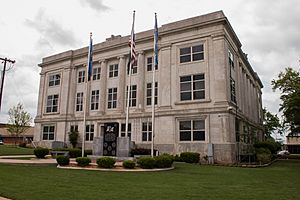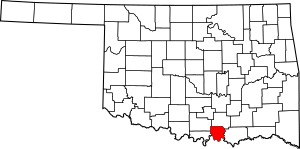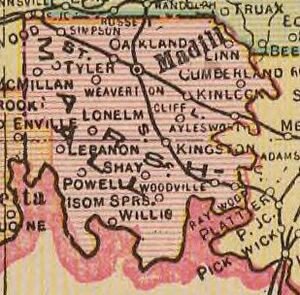Marshall County, Oklahoma facts for kids
Quick facts for kids
Marshall County
|
|
|---|---|

Marshall County Courthouse
|
|

Location within the U.S. state of Oklahoma
|
|
 Oklahoma's location within the U.S. |
|
| Country | |
| State | |
| Founded | 1907 |
| Seat | Madill |
| Largest city | Madill |
| Area | |
| • Total | 427 sq mi (1,110 km2) |
| • Land | 371 sq mi (960 km2) |
| • Water | 56 sq mi (150 km2) 13%% |
| Population
(2020)
|
|
| • Total | 15,312 |
| • Density | 35.86/sq mi (13.845/km2) |
| Time zone | UTC−6 (Central) |
| • Summer (DST) | UTC−5 (CDT) |
| Congressional district | 2nd |
Marshall County is a county in south-central Oklahoma. It sits right on the border with another state. In 2020, about 15,312 people lived here.
The main town and county seat is Madill. Marshall County was created in 1907 when Oklahoma became a state. It was named after the mother of George Henshaw, who helped write Oklahoma's constitution. This county and its towns are part of the Texoma region.
Contents
History of Marshall County
The land that is now Marshall County was once set aside by the U.S. government. It was for the Choctaw and Chickasaw tribes. These tribes moved here from their homes in the southeastern United States. The Chickasaws started moving to this area in 1837.
The U.S. Army built Fort Washita in 1842. This fort helped protect the new settlers from attacks by other tribes. In 1857, the Chickasaw Nation officially separated from the Choctaw Nation. This area then became part of Pickens County in the Chickasaw Nation.
Railroads arrived in Marshall County in 1901. The "Frisco" railway built a line going north and south. The next year, another railway laid tracks from east to west. This line was later sold to the Frisco in 1907. In 1941, part of this railway line was moved. This was done to make space for the new Lake Texoma.
Geography and Nature
Marshall County covers about 427 square miles. Of this, 371 square miles are land, and 56 square miles are water. This means about 13% of the county is water. It is the smallest county in Oklahoma by land area. It is also the third-smallest by total area.
The Red River flows through the county. It forms the county's southern border. In 1942, the Denison Dam was finished. This created Lake Texoma. The lake covered some of Marshall County's land. It now forms the county's southern and eastern borders.
Main Roads in Marshall County
Neighboring Counties
- Johnston County (to the north)
- Bryan County (to the east)
- Grayson County, Texas (to the south)
- Love County (to the west)
- Carter County (to the northwest)
Protected Natural Areas
- Tishomingo National Wildlife Refuge (part of it is in Marshall County)
Population of Marshall County
| Historical population | |||
|---|---|---|---|
| Census | Pop. | %± | |
| 1910 | 11,619 | — | |
| 1920 | 14,674 | 26.3% | |
| 1930 | 11,026 | −24.9% | |
| 1940 | 12,384 | 12.3% | |
| 1950 | 8,177 | −34.0% | |
| 1960 | 7,263 | −11.2% | |
| 1970 | 7,682 | 5.8% | |
| 1980 | 10,550 | 37.3% | |
| 1990 | 10,829 | 2.6% | |
| 2000 | 13,184 | 21.7% | |
| 2010 | 15,840 | 20.1% | |
| 2020 | 15,312 | −3.3% | |
| U.S. Decennial Census 1790-1960 1900-1990 1990-2000 2010 |
|||
In 2000, there were 13,184 people living in Marshall County. By 2020, the population had grown to 15,312 people. The county has a mix of different backgrounds. Most people are White, but there are also many Native American and Hispanic or Latino residents.
About 23.5% of the people in the county are under 18 years old. The average age of people living here is 41 years old.
Economy and Jobs
For a long time, Marshall County's economy was mostly about farming and raising animals. Cotton and corn were the main crops grown. By 1934, oats also became a big crop. After Lake Texoma was created, cotton and corn farming decreased a lot. Peanuts then became the third largest crop. By 2001, wheat was the biggest crop, followed by rye, oats, and peanuts.
Oil and gas production started soon after the county was formed. In 1940, a company built an oil camp with many houses. This camp closed in 1959. By the early 2000s, oil production was much lower than it was in 1975. Gas production was also less.
Other important businesses in Marshall County include making wood products. They also make things like livestock trailers. Tourism is also a big part of the economy, especially with Lake Texoma nearby.
Towns and Communities
City
- Madill (This is the county seat, meaning it's the main administrative town.)
Towns
Census-designated places
These are areas that are like towns but are not officially incorporated.
- Cumberland
- Lebanon
- Little City
- McBride
Other Unincorporated Places
These are smaller communities that are not officially towns or cities.
See also
 In Spanish: Condado de Marshall (Oklahoma) para niños
In Spanish: Condado de Marshall (Oklahoma) para niños


